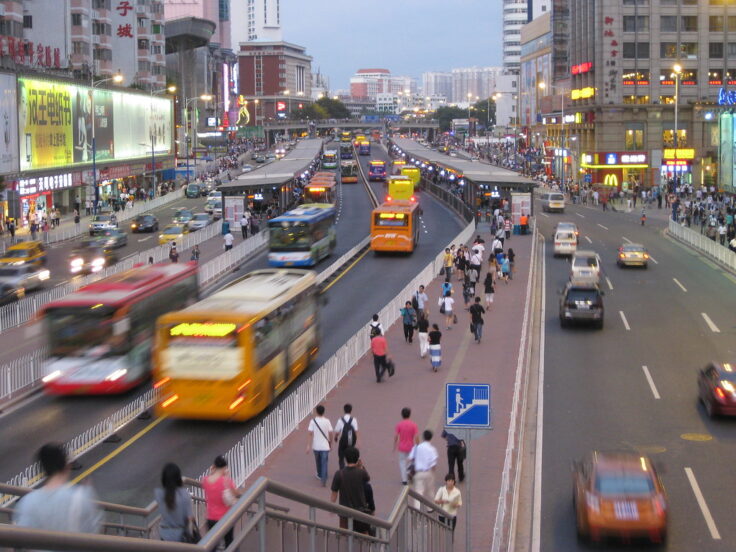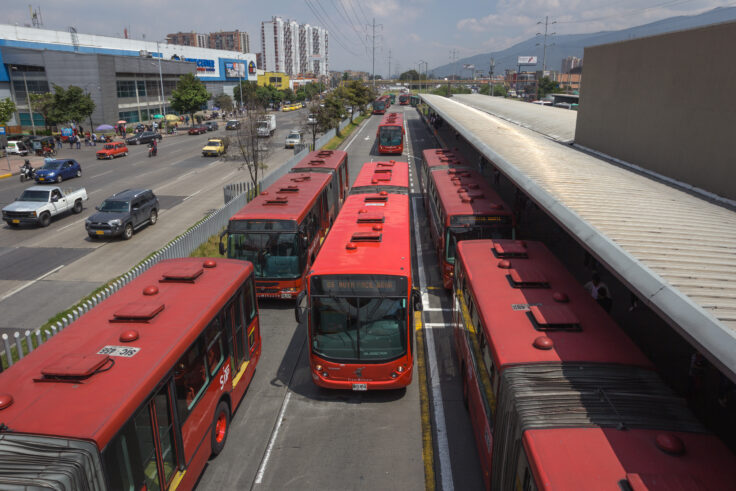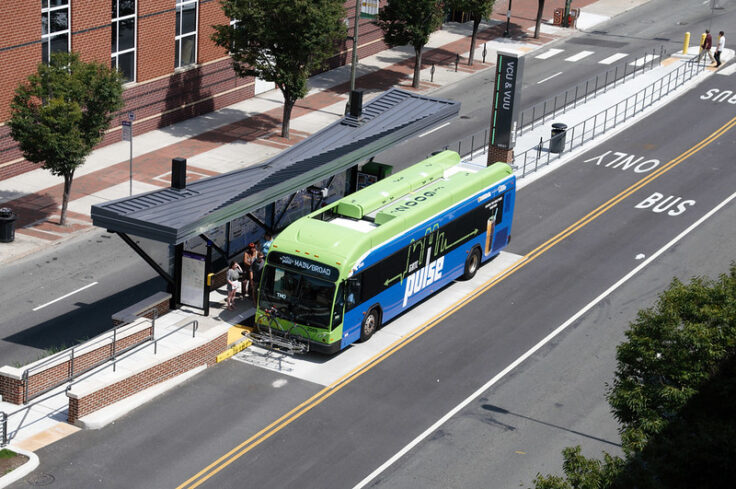January 18, 2024
Cities Need Good Public Transport Now More Than Ever – BRT Shows Us How
A version of this article was originally published in the No. 35 issue of the Sustainable Transport Magazine. Read it here.
By Jacob Mason, ITDP
The COVID-19 pandemic had clear and significant impacts on public transport systems worldwide. As public health concerns in cities limited the mobility of many, the International Energy Agency reported a nearly 50% fall in global road transport activity in the first few months of the crisis. Now, over four years since the start of the pandemic, many public transport systems are still recovering from a decline in ridership and funding, and many more continue to struggle with an ongoing lack of resources.
High-quality, reliable public transport is essential to all cities, especially in lower- and middle-income countries where public transport is often the only accessible option for millions of people. High-quality public transport is also critical to addressing the growing emissions, congestion, inequality, and traffic violence associated with increases in private vehicle usage. As cities face future crises, they must implement and support robust transport infrastructure and services that acknowledge the diverse needs of their populations.
What Makes Good Public Transport?
A ‘good’ public transport system for today’s world is one where a person can safely and reliably reach as many (or more) places as quickly by public transport as they could by private car or motorcycle. Good public transport also prioritizes the needs of people who have been historically marginalized or who have the fewest mobility options, particularly women, children, people with low incomes, and people with disabilities. Good public transport must have several essential qualities, which ITDP refers to as the seven ‘C’s:
- Connective: A comprehensive network of frequent service, including during off-peak and weekend hours, means short wait times between public transport services, leading to shorter trips and service to nearly all parts of the city.
- Convenient: When public transport is accessible to all, people with disabilities, older people, women, and people traveling with children or goods can use the system.
- Consistent: Better reliability means the times between public transport services are more consistent, reducing waits and improving the ability of people to reach destinations.
- Comfortable: Safe services are operated in a way that avoids crashes, especially with vulnerable road users, like people walking and cycling.
- Cost-effective: Affordable fares are set so almost everyone can afford to use the service regularly, with little to no additional cost for using multiple modes in a trip.
- Customer-friendly: The easier a system is to understand and navigate, the more people can use it to move quickly around their city.
- Clean: Services that emit little to no pollution may lower barriers to expanding public transport and improve passenger experience by reducing air and noise pollution.
The more a system can improve these qualities, the better support it can provide its passengers. Planning decisions about public transport are certainly never simple. Each city’s transport system has unique strengths, weaknesses, and concerns, and each project and policy comes with benefits and costs that must be considered with local contexts. There is no universal path forward. However, good public transport will always be crucial to a well-functioning city, and the characteristics of good public transport are in fact universal. Drawing on ITDP’s long history working on transport projects worldwide, we know that well-built and well-maintained bus rapid transit (BRT) can offer cities all the elements of an inclusive, quality public transport system.

The Promise and Need for BRT in Cities
BRT is a proven example of a public transport system that can employ the ‘C’s of good public transport quickly and at a relatively low cost. In a BRT system, buses operate on a dedicated busway, typically at grade and in the center of a street. By removing much of the traffic that impedes typical bus service and adding other time-saving elements such as level-boarding and off-board fare collection, BRT has much higher travel speeds, safer operations, and better reliability than standard bus services.
With BRT, cities can quickly build a high-capacity network and high- quality public transport services. And because BRT is built around the elements of good public transport, it can readily demonstrate how public transport can operate effectively within the city’s overall transport system. Building on this foundation, cities can then integrate other transport modes, such as walking, cycling, and paratransit, with BRT to improve overall mobility connections within cities.
Bogotá, Colombia, has embodied this type of transport transformation. A few decades ago, much of the public transport in Bogotá was informally operated. The city then built Transmilenio, a network of BRT routes that spanned the metropolitan area. The system attracted so many riders that its primary problem became overcrowding. Building on this success, the city incorporated private operators into its overall public transport system and added subsidies to ensure good quality services. Bogotá now has one of the highest rates of public transport population coverage, according to initial data in ITDP’s soon-to-be-released Atlas of Urban Transport platform. The city is also constructing its first-ever metro line, integrated with the BRT and other public transport services.

At the country level, Colombia has shown how BRT can allow a region to grow its rapid transport networks quickly. As late as 1994, Colombia did not have a single kilometer of BRT, light rail transit, or metro. Thirty years later, urban residents in Colombia are now twice as likely to live close to rapid transit as their peers in Germany and China, which are well-known for their investments in public transport. The interest in affordable, expansive BRT infrastructure has spread around the world. In the United States, BRT ridership is seeing a surge back to pre-pandemic levels in many cities and, in rapidly urbanizing countries like Mexico and across Africa, rapid transit networks are being built mainly around the existing BRT hubs.
In Indonesia, Jakarta’s well-known BRT system known as TransJakarta first launched in 2004 and initially ran just through a 12-kilometre dedicated lane. Now, nearly two decades later, it has grown to become the world’s longest BRT system, spanning more than 251 kilometers (156 miles), and service a region with a population well over 11 million. The fare per trip also has also generally not gone up since the launch of the system as a result of government subsidies that aim to make the system affordable, accessible, and usable by all. In addition, a feeder system of hundreds of microbuses has helped the BRT system expand to cover nearly 88% of Jakarta’s sprawling neighborhoods and satellite cities.
There are now 240 BRT routes across the city, and the Transjakarta fleet has quadrupled to more than 4,600 buses over two decades. Transjakarta’s impact and role in the city has only continued to grow in recent years, despite the pandemic — in both 2020 and 2023, the system recorded more than one million riders in one day. The Jakarta government has now committed to electrifying 100% of its urban bus fleet by 2030, demonstrating that sustainable, accessible, and quality public transport systems are both essential and possible for major cities.

Over 150 BRT corridors have opened in more than 90 cities in 24 countries over the past decade.
In the United States, the development and interest in BRT systems is also on the rise. More recently launched and lauded systems like the Pulse BRT in Richmond, Virginia, which began operations in 2018, have set examples of successful public transport for the rest of the country. The system has widely exceeded ridership expectations since its launch, with the busiest route carrying an average of more than 7,000 riders every weekday, nearly double the service’s original ridership goals.
Most notably, while other US cities continued to deal with declining public transport usage since 2020, Richmond’s transit passenger counts had returned to pre-pandemic levels according to the city. Local officials primarily attribute this success to their strategic focus on redesigning bus routes, subsidizing fares, and promoting BRT in particular. While the Pulse currently runs just along a 7.6-mile route, the city is now planning additional north-south corridors that could double or even triple its reach.
A New Standard for BRT
Since 2012, over 153 BRT corridors have opened in 91 cities in 24 countries, and these systems are now a far more familiar concept. ITDP has supported that growth, working in cities worldwide to develop high-quality public transport — often based on the backbone of BRT. ITDP and our partners first developed the BRT Standard in 2012 to ensure that BRT corridors consistently provide high-quality service and promote ridership. With the upcoming third edition of the Standard, ITDP is increasing its focus on equity, inclusion, and sustainability, reflecting the realities of a transport sector transformed by weather events and the global pandemic.
The third edition of the Standard aims to help cities create more resilient rapid transit systems as a whole, while also addressing today’s myriad of urban and social challenges from climate change to wealth inequality. Notably, the new Standard highlights the need for accessibility for all populations, particularly for people with disabilities, people with low incomes, children, caregivers, and older populations. BRT is particularly well suited to addressing these dynamic challenges, providing mass transit in a shorter time frame for lower costs than other options like rail or metro infrastructure. Most importantly, BRT demonstrates that high-quality, efficient, and reliable public transport can function well and serve the needs of diverse global cities.

Ultimately, if it is done well and based on elements of reliability, inclusivity, and quality, BRT can certainly be a model for the importance of good urban public transport, all in a single project. What’s more, given that it can often be built at a relatively low cost and in a shorter time frame than other transit systems, cities may benefit from BRT now more than ever as they seek to deal with growing crises. There is an urgent need to invest in and reinvigorate public transport in our cities for environmental, social, and accessibility concerns. BRT, integrated with broader frameworks of compact, mix-use neighborhoods centered around walking, cycling, and green space, can hold the key for our urban future.
Nevertheless, any efforts to improve a city’s transport infrastructure must start with decision-makers identifying and making use of the resources and tools available to them. They must assess how well new projects and policies align with the city’s goals, how they fit within budgets, and how they address issues of equity and inclusion. By asking the right questions and evaluating logical outcomes, it is possible for urban planners, decision-makers, and funders to find solutions that best serve their city and their people. As cities grapple with the future of their infrastructure, it is crucial to remember that the most significant benefit of public transport is its geometry: it moves many people in a small amount of space.
BRT systems that are well-built, maintained, and operated can offer cities a way to bring people back on board with public transport. Stay up-to-date on the 2024 edition of The BRT Standard.
